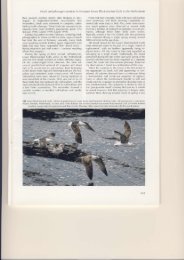Identification of American Herring Gull in a western European context
Identification of American Herring Gull in a western European context
Identification of American Herring Gull in a western European context
Create successful ePaper yourself
Turn your PDF publications into a flip-book with our unique Google optimized e-Paper software.
<strong>Identification</strong> <strong>of</strong> <strong>American</strong> <strong>Herr<strong>in</strong>g</strong> <strong>Gull</strong> <strong>in</strong> a <strong>western</strong> <strong>European</strong> <strong>context</strong>nianus, particularly the birds at the lighter end <strong>of</strong>the range. This would help us determ<strong>in</strong>e theidentity <strong>of</strong> a number birds already observed <strong>in</strong>Europe which have closely resembled whatmight be described as ‘light smithsonianus’, butwhich have exhibited an ambiguous, or moreargentatus-like tail pattern and/or upper- andundertail-covert mark<strong>in</strong>gs. Some, it appears, maybe hybrids but if so, what is the parentage? Is itpossible that smithsonianus has already enteredthe <strong>European</strong> <strong>Herr<strong>in</strong>g</strong> <strong>Gull</strong> gene pool, and couldthis be the explanation for the appearance <strong>of</strong>some <strong>of</strong> the more perplex<strong>in</strong>g birds? We suggestthat a thorough <strong>in</strong>vestigation <strong>of</strong> morphologicalvariation <strong>in</strong> the Icelandic <strong>Herr<strong>in</strong>g</strong> <strong>Gull</strong> population,comb<strong>in</strong>ed with judicious sampl<strong>in</strong>g and analysis<strong>of</strong> genetic material could help answer some<strong>of</strong> these questions.It is good to hear that smithsonianus is, at last,the subject <strong>of</strong> some new taxonomic studies be<strong>in</strong>gcarried out by North <strong>American</strong> research teams(Pierre-André Crochet <strong>in</strong> litt). Of course, we donot know what this work will entail, but we canspeculate as to the advances that might be madeif it attempted to evaluate whether morphologicallydist<strong>in</strong>ct ‘types’ (Jonsson & Mactavish 2001)warranted taxonomic dist<strong>in</strong>ction. We can alsoimag<strong>in</strong>e how a large-scale colour-r<strong>in</strong>g<strong>in</strong>g projectmight stimulate great <strong>in</strong>terest <strong>in</strong> observ<strong>in</strong>g whatthese (and other, yet-to-be-identified?) types looklike as immatures, and where they go outside thebreed<strong>in</strong>g season, just as it has <strong>in</strong> Europe.F<strong>in</strong>ally, we are very <strong>in</strong>terested <strong>in</strong> receiv<strong>in</strong>gfeedback, both positive and negative, fromobservers whose experience <strong>of</strong> any <strong>of</strong> the taxadiscussed here is complementary to our own.Increas<strong>in</strong>gly, <strong>in</strong> recent years, it has been thepool<strong>in</strong>g <strong>of</strong> <strong>in</strong>formation and exchang<strong>in</strong>g <strong>of</strong> ideasthat has been responsible for advanc<strong>in</strong>g ourunderstand<strong>in</strong>g <strong>of</strong> this most challeng<strong>in</strong>g group.AcknowledgementsWe wish to express our gratitude to the follow<strong>in</strong>gpeople who helped <strong>in</strong> various ways, from provid<strong>in</strong>gphotographs for reference to stimulat<strong>in</strong>g discussionand company <strong>in</strong> the field: Joe Adamson,Mashuq Ahmad, Paul Archer, Theo Bakker,Mart<strong>in</strong> Elliott, Frode Falkenberg, Sean Farrell,Mart<strong>in</strong> Garner, Peter de Knijff, Diederik Kok,Henry Lehto, Anthony McGeehan Richard83 <strong>American</strong> <strong>Herr<strong>in</strong>g</strong> <strong>Gull</strong> / Amerikaanse Zilvermeeuw Larus smithsonianus, adult, Boston, Massachusetts, USA,January 2001 (Pat Lonergan). Note rather blotchy head pattern and very f<strong>in</strong>e blackish shaft-streaks on primarycoverts.31










